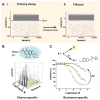Apparent activity in high-throughput screening: origins of compound-dependent assay interference
- PMID: 20417149
- PMCID: PMC2878863
- DOI: 10.1016/j.cbpa.2010.03.020
Apparent activity in high-throughput screening: origins of compound-dependent assay interference
Abstract
Expansive compound collections made up of structurally heterogeneous chemicals, the activities of which are largely undefined, present challenging problems for high-throughput screening (HTS). Foremost is differentiating whether the activity for a given compound in an assay is directed against the targeted biology, or is the result of surreptitious compound activity involving the assay detection system. Such compound interference can be especially difficult to identify if it is reproducible and concentration-dependent - characteristics generally attributed to compounds with genuine activity. While reactive chemical groups on compounds were once thought to be the primary source of compound interference in assays used in HTS, recent work suggests that other factors, such as compound aggregation, may play a more significant role in many assay formats. Considerable progress has been made to profile representative compound libraries in an effort to identify chemical classes susceptible to producing compound interference, such as compounds commonly found to inhibit the reporter enzyme firefly luciferase. Such work has also led to the development of practices that have the potential to significantly reduce compound interference, for example, through the addition of non-ionic detergent to assay buffer to reduce aggregation-based inhibition.
Published by Elsevier Ltd.
Conflict of interest statement
Figures


References
-
- Austin CP, Brady LS, Insel TR, Collins FS. NIH Molecular Libraries Initiative. Science. 2004;306:1138–1139. - PubMed
-
- Lazo JS. Roadmap or roadkill: a pharmacologist’s analysis of the NIH Molecular Libraries Initiative. Mol Interv. 2006;6:240–243. - PubMed
-
- Rishton GM. Nonleadlikeness and leadlikeness in biochemical screening. Drug Discov Today. 2003;8:86–96. - PubMed
-
- Inglese J, Johnson RL, Simeonov A, Xia M, Zheng W, Austin CP, Auld DS. High-throughput screening assays for the identification of chemical probes. Nat Chem Biol. 2007;3:466–479. A comprehensive review that covers appropriate design and use of HTS assays, especially as pertains to specific biological targets and pathways, and provides a succinct introduction to compound interference in HTS. - PubMed
Publication types
MeSH terms
Substances
Grants and funding
LinkOut - more resources
Full Text Sources
Other Literature Sources

